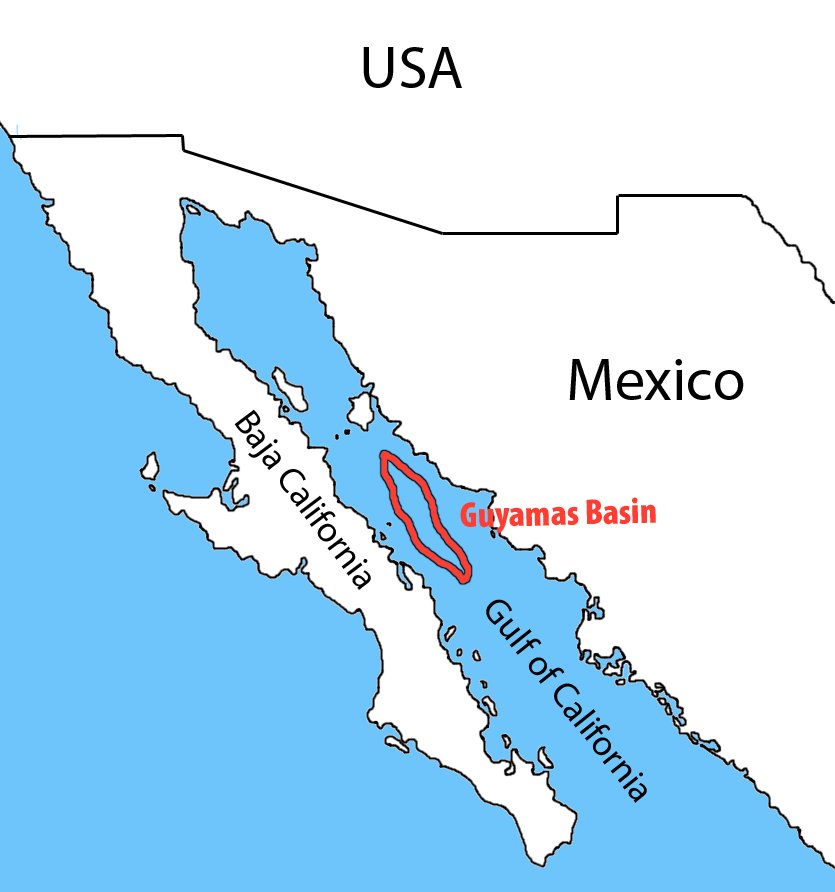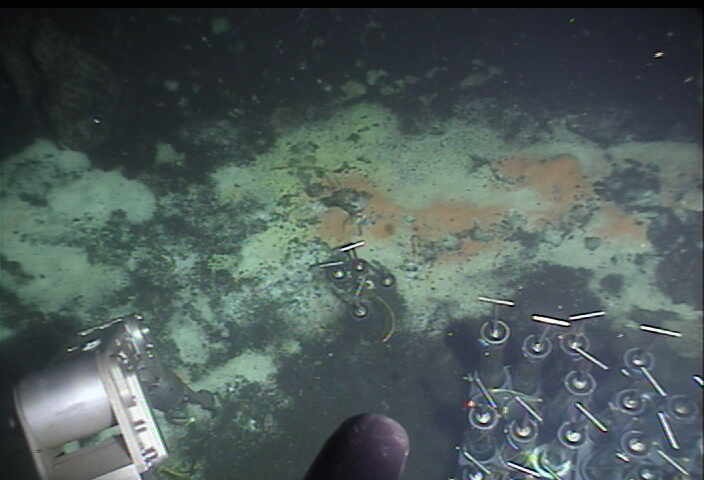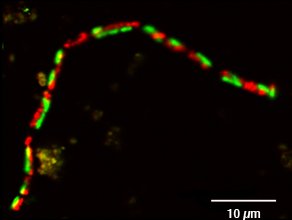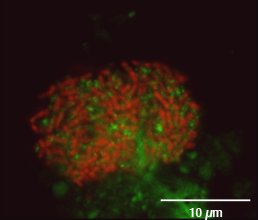Page path:
- Press Office
- Press releases 2011
- 14.09.2011 Microbes at hydrothermal vents elimi...
14.09.2011 Microbes at hydrothermal vents eliminate the greenhouse gas methane
Marine sediments store large amounts of the greenhouse gas methane, which is produced either by microbial metabolism or by geothermal processes. However, methane rarly reaches the atmosphere and unfolds its detrimental impact to the climate, because it is degraded for the most part in the sediment. Now Max Planck researchers report on new microbial communities that can degrade methane in the absence of oxygen at high temperatures of up to 70 °C.
Only few specialized microorganisms are able to degrade the greenhouse gas methane. For some of them oxygen plays a role as oxidant whereas others degrade methane in the absence of oxygen. For the degradation of methane without oxygen microorganisms require particular conditions, for instance a close community of bacteria and archaea. In the process of anaerobic oxidation of methane (AOM) methane is turned over with sulfate as oxidant. Both partners of the consortia benefit from each other in that the archaea use the methane whereas the bacteria gain energy from a so far unidentified intermediate product and sulfate.
To date the communities of methane oxidizing archaea and sulfate reducing bacteria were only found in habitats with cold and temperate temperature conditions of -1,5-20 °C. Yet for a long time microbiologists have known that the microbial processes of sulfate reduction and methanogenesis, a process related to the anaerobic oxidation of methane, proceed at temperatures of up to 100 °C. Hence, the Max Planck researchers started the quest for AOM consortia that are also active at high temperatures.
Only few specialized microorganisms are able to degrade the greenhouse gas methane. For some of them oxygen plays a role as oxidant whereas others degrade methane in the absence of oxygen. For the degradation of methane without oxygen microorganisms require particular conditions, for instance a close community of bacteria and archaea. In the process of anaerobic oxidation of methane (AOM) methane is turned over with sulfate as oxidant. Both partners of the consortia benefit from each other in that the archaea use the methane whereas the bacteria gain energy from a so far unidentified intermediate product and sulfate.
To date the communities of methane oxidizing archaea and sulfate reducing bacteria were only found in habitats with cold and temperate temperature conditions of -1,5-20 °C. Yet for a long time microbiologists have known that the microbial processes of sulfate reduction and methanogenesis, a process related to the anaerobic oxidation of methane, proceed at temperatures of up to 100 °C. Hence, the Max Planck researchers started the quest for AOM consortia that are also active at high temperatures.
Left: Submersible Alvin of the Woods Hole Oceanographic Institution (WHOI) that was used by the scientistst and their colleagues from the WHOI to take the sediment samples at 2000 m depth and to bring them to the reserach vessel (Shelley Dawicky © Woods Hole Oceanographic Institution). Right: The bottom of the Guaymas Basin where the sediment cores were taken with Alvin (Courtesy of the Woods Hole Oceanographic Institution).
Thomas Holler and his colleagues found what they were looking for in sediment samples from the Guaymas Basin in which they traced the degradation of methane under oxygen-free conditions. The Guaymas Basin lies in the Gulf of California in Mexico on an oceanic ridge, a seismic active area. New earth crust forms along this ridge due to spreading tectonic plates. Rising, hot basalt heats the sediment, thereby breaking down deposited organic material to petroleum, methane and other hydrocarbons. Hot pore fluids emerge from the sediment and form hydrothermal vents that host a multitude of microorganisms that live on the degradation of hydrocarbons. To examine the sediment, the scientists brought up sediment cores from over 2000 m depth with the manned research submersible Alvin.
Thomas Holler says: „In the laboratory we incubated the samples and examined them with an array of biogeochemical and molecular techniques. Thereby we could demonstrate that the anaerobic oxidation of methane is driven by a microbial consortium that performs optimally at 50 °C. The microbial community is even able to process methane at temperatures of up to 70 °C. By the degradation rate of methane (AOM rate) we could calculate a doubling time of 68 days at 50 °C.“ His colleague Gunter Wegener adds: „This may seem slow, but for microorganisms that live under extreme conditions in the deep sea, where doubling times of up to several hundreds of years are not uncommon, this is considerably fast.
The AOM community that has now been discovered in the Guaymas Basin consists of a novel group of methane oxidizing archaea that are closely related to the known archaeal group ANME-1 (ANarobic MEthane degraders), and sulfate reducing bacteria. The latter belong to the delta proteobacteria and are phylogenetically distantly related to sulfate reducers that have been identified as partners of ANME-1 archaea in former investigations. The two partners form aggregates of up to several hundreds of cells. The truly remarkably about the Guaymas consortia is that some of them inhabit a common, chain-like sheath. This chain-like aggregation was found for the first time for AOM organisms.
Thomas Holler says: „In the laboratory we incubated the samples and examined them with an array of biogeochemical and molecular techniques. Thereby we could demonstrate that the anaerobic oxidation of methane is driven by a microbial consortium that performs optimally at 50 °C. The microbial community is even able to process methane at temperatures of up to 70 °C. By the degradation rate of methane (AOM rate) we could calculate a doubling time of 68 days at 50 °C.“ His colleague Gunter Wegener adds: „This may seem slow, but for microorganisms that live under extreme conditions in the deep sea, where doubling times of up to several hundreds of years are not uncommon, this is considerably fast.
The AOM community that has now been discovered in the Guaymas Basin consists of a novel group of methane oxidizing archaea that are closely related to the known archaeal group ANME-1 (ANarobic MEthane degraders), and sulfate reducing bacteria. The latter belong to the delta proteobacteria and are phylogenetically distantly related to sulfate reducers that have been identified as partners of ANME-1 archaea in former investigations. The two partners form aggregates of up to several hundreds of cells. The truly remarkably about the Guaymas consortia is that some of them inhabit a common, chain-like sheath. This chain-like aggregation was found for the first time for AOM organisms.
Microscope images of the AOM consortia. The methane oxidizing archaea are in red, the sulfate reducing bacteria are in green. On the left-hand side are the novel chain-like aggregates (© Thomas Holler, Kathrin Knittel).
The scientists could show that the anaerobic oxidation of methane is not limited to cold and temperate marine sediments. Thomas Holler says: „ During AOM and subsequent reactions insoluble carbonates form from methane and sulfate is consumed. Our new challenge is to investigate which contribution these consortia make to the global methane degradation and which role they play in geological rock formation, for instance the transformation of anhydrite (CaSO4) to calcite (CaCO3). With this we could describe their function in the global carbon cycle more precisely.
Rita Dunker
For further information, please contact
Dr. Thomas Holler, Tel. +49 (0)421 2028 732, [Bitte aktivieren Sie Javascript]
Dr. Gunter Wegener, Tel. +49 (0)421 2028 867, gwegener@
mpi-bremen.de
or the public relations office
Dr. Rita Dunker, Tel. +49 (0)421 2028 856, [Bitte aktivieren Sie Javascript]
Dr. Manfred Schlösser +49 (0)421 2028 704 mschloes@
mpi-bremen.de
Involved institutions
Max Planck Institute for Marine Microbiology, Bremen, Germany
MARUM, Center for Marine Environmental Sciences, University of Bremen, Bremen, Germany
Department of Marine Sciences, The University of North Carolina at Chapel Hill, Chapel Hill, North Carolina, USA
Alfred Wegener-Institute for Polar and Marine Research, Bremerhaven, Germany
Original article
Thermophilic anaerobic oxidation of methane by marine microbial consortia. T. Holler, F. Widdel, K. Knittel, R. Amann, M. Y. Kellermann, K.-U. Hinrichs, A. Boetius, and G. Wegener. ISME Journal
DOI: 10.1038/ismej.2011.77
Rita Dunker
For further information, please contact
Dr. Thomas Holler, Tel. +49 (0)421 2028 732, [Bitte aktivieren Sie Javascript]
Dr. Gunter Wegener, Tel. +49 (0)421 2028 867, gwegener@
mpi-bremen.de
or the public relations office
Dr. Rita Dunker, Tel. +49 (0)421 2028 856, [Bitte aktivieren Sie Javascript]
Dr. Manfred Schlösser +49 (0)421 2028 704 mschloes@
mpi-bremen.de
Involved institutions
Max Planck Institute for Marine Microbiology, Bremen, Germany
MARUM, Center for Marine Environmental Sciences, University of Bremen, Bremen, Germany
Department of Marine Sciences, The University of North Carolina at Chapel Hill, Chapel Hill, North Carolina, USA
Alfred Wegener-Institute for Polar and Marine Research, Bremerhaven, Germany
Original article
Thermophilic anaerobic oxidation of methane by marine microbial consortia. T. Holler, F. Widdel, K. Knittel, R. Amann, M. Y. Kellermann, K.-U. Hinrichs, A. Boetius, and G. Wegener. ISME Journal
DOI: 10.1038/ismej.2011.77





